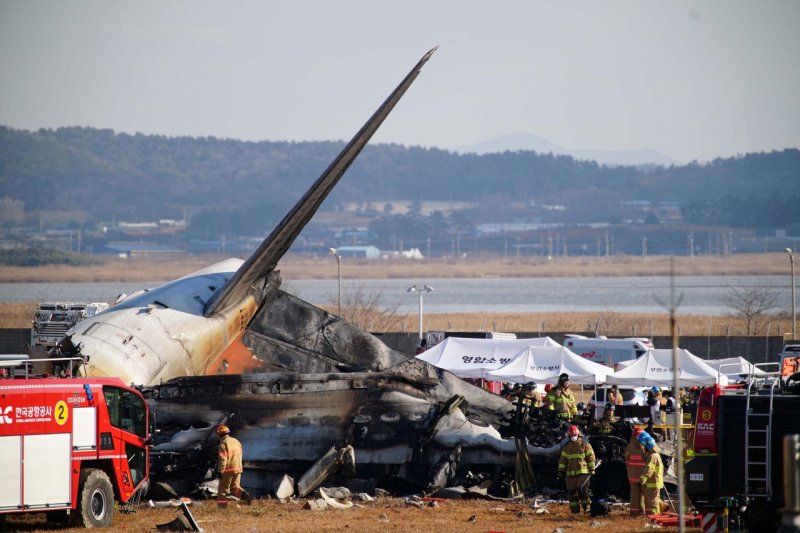South Korea Plane Crash Investigations Intensify as Questions Raised over Airport Embankment
The investigation into Sunday’s plane crash in South Korea, in which all but two of the 181 people onboard died, has intensified as authorities come under pressure to explain how the jetliner lost control.
Families of the dead – 175 passengers and four crew – remained at Muan international airport, the scene of the deadliest plane crash on South Korean soil, to demand more information from authorities, while the government announced it was reviewing the regulations relating to a concrete wall near the runway that has been blamed for the huge loss of life.
The National Police Agency said it had enlisted additional officials and would use rapid DNA analysers to speed up the identification of five bodies. All of the other victims have been identified but most remain at a temporary morgue at the airport.
The exact cause of the crash is still unknown. Early theories centred on a bird strike, although some experts do not believe a collision of that kind – a relatively common occurrence in aviation – would have been forceful enough to prevent the pilot from lowering the Boeing 737-800’s landing gear as it approached the runway.
Bird strikes aside, investigators are trying to establish if any of the aircraft’s control systems were disabled, as well as why the pilot apparently attempted to land so soon after declaring an emergency. The plane, powered by two CFM 56-7B26 engines, appeared to be travelling at great speed when the pilot attempted a “belly landing”.
“I can’t think of any reason for being forced to make a landing like this,” said John Nance, an aviation safety expert and former military and commercial pilot who flew 737s for Alaska Airlines.
Jeju Air’s chief executive, Kim Yi-bae, said maintenance staff had not flagged any problems with the aircraft when it was inspected before takeoff on Sunday.
Speaking at a televised press conference, Kim said no abnormalities had been identified with the landing gear, which failed to deploy as the plane prepared to land at Muan. “The question of whether the landing gear was working properly or not is related to the accident investigation,” Kim said.
He added that the airline would reduce its winter services by between 10-15% and strive to win back the trust of the travelling public.
Kim said that all safety protocols had been followed on the day of the accident, saying a plane would not be allowed to take off if the maintenance team had not signed off on its safety.
Criticism was mounting of Muan airport’s layout, with aviation experts questioning why a large dirt-and-concrete embankment used to support navigation equipment had been built about 250 metres from the end of the runway.
The victims are thought to have died after Jeju Air flight 7C2216, arriving from Bangkok, crashed into the barrier, throwing passengers into the surrounding fields.
South Korean officials said the embankment was built according to industry standards, adding that airports in other countries had similar features.
The government said on Tuesday it was reviewing whether the wall met regulations. Asked it was it was permissible for the airport to have used concrete – which some experts described as unsafe – the director-general for airport policy, Kim Hong-rak, said the government would “review the relevant regulations and their application”.
Experts have also questioned the need to build the wall so close to the end of the runway. The runway design did not meet industry best practices, which preclude any hard structure such as a berm – a raised bank – within at least 300 metres of the runway’s end, claimed John Cox, the chief executive of Safety Operating Systems and a former 737 pilot.
The crash poses a serious challenge to South Korea’s new acting president, Choi Sang-mok, who has ordered an emergency safety inspection of the county’s entire airline operation, while the transport ministry will inspect all 101 Boeing 737-800s in operation in the country by the end of the week.
Choi, who replaced the impeached former president Han Duck-soo at the weekend, said the priority was to identify the remaining victims and support the passengers’ families. “Even before the final results are out, we ask that officials transparently disclose the accident investigation process and promptly inform the bereaved families,” he said at a disaster management meeting.
Choi immediately declared a seven-day period of mourning and paid his respect at a memorial at the crash site. Similar memorials have been set up at other locations around the country, and flags were flying at half mast.
Representatives from the US National Transportation Safety Board, Federal Aviation Administration, and aircraft manufacturer Boeing have joined the investigative body and planned to meet in Muan, 186 miles south-west of Seoul, on Tuesday.
Establishing the cause of the accident could prove more complicated and time-consuming than usual, after the ministry said the plane’s damaged flight data recorder was missing key pieces, making it more difficult to extract its data. The second “black box” containing the cockpit voice recorder was in better condition, the Yonhap news agency said.
Park Han-shin, whose brother died in the crash, said he had been told by authorities that his brother had been identified but added he had not been able to see his body.
South Korean authorities will be under pressure to avoid a repeat of the aftermath of the Sewol ferry disaster in April 2014, in which more than 300 people, mostly high school students, died. Many relatives of the victims complained it took authorities too long to identify the dead and to establish the cause of the accident.
The bodies of four of the identified victims in Sunday’s crash have been handed over to their families, Yonhap said, citing local officials.
(Source: The Guardian)













